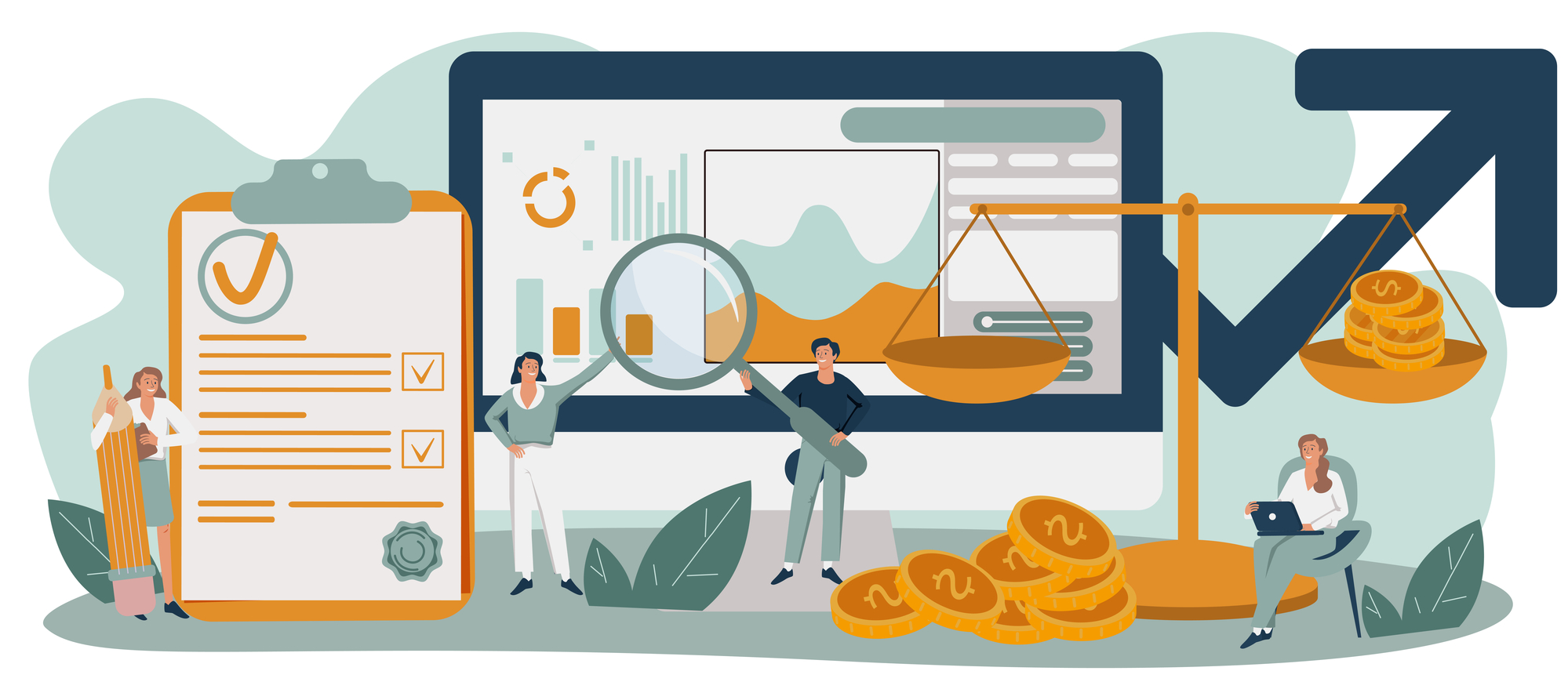
Mercedes Holmes
Whether you are a freelancer, a solopreneur, or a small business owner, you are going to need a reliable way to track your hours so that you can estimate costs, allocate your time appropriately, bill your clients accurately, and receive the full compensation that you are entitled to.
There are several options when it comes to tracking your hours. You could choose the simple pen-and-paper manual timesheet option, or you could splurge on accounting software, and a project time tracking suite to keep track of work hours and pay. You can also choose a practical, and often free solution that falls somewhere between these two extremes.
At the end of the day, the best way to track your hours will depend on the type of work you are performing, your typical work schedule, your business structure, and many other important factors unique to you or your organization.
In this article, we will take a look at some of the most popular ways to track your hours, from the basic to the complex, and help you determine which time tracking solution is the best fit for you.
Manual Spreadsheet Time Tracking
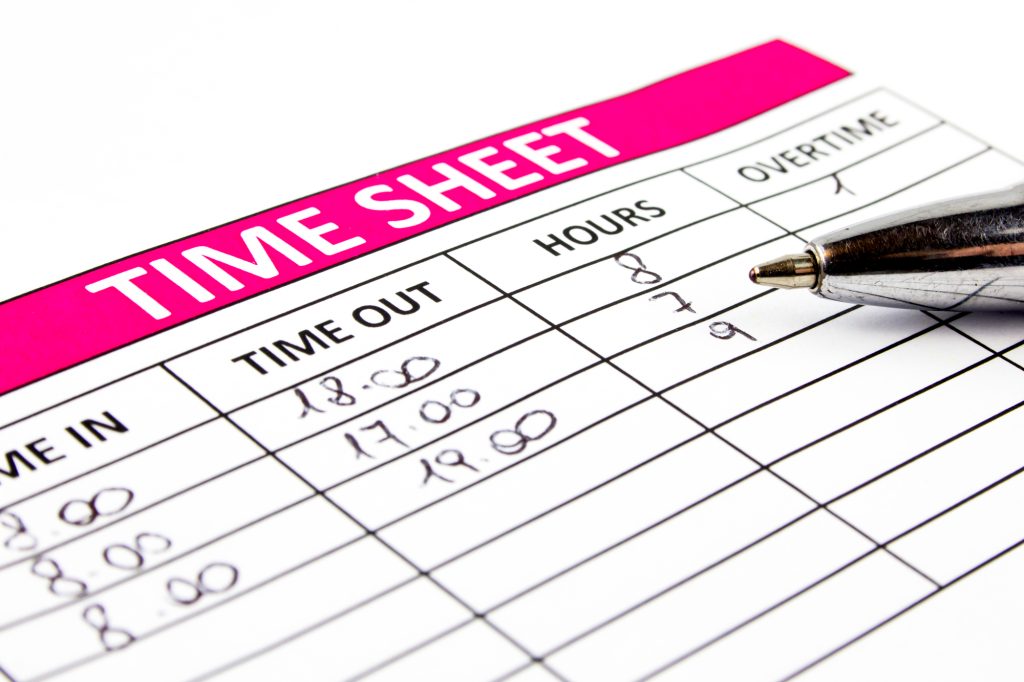
Image Credit: Mayalain at DepositPhotos
There is nothing simpler or more low-tech than the basic pencil-and-paper method of time tracking. At the simplest level, you could track your hours by jotting down your tasks, and how much time you spent completing each one in a paper ledger.
The clear benefit of this old-school method is the ability to record your time anywhere, at any time, and with no need for a computer, smartphone, or internet connection. The disadvantage is that this method is prone to errors, and it is difficult, if not impossible, to verify to ensure the accuracy of the tracked work hours, making it an unreliable resource for accurate billing.
Digital timesheets can offer a more convenient method of manually tracking your hours. Most popular word processing platforms offer a spreadsheet program and free online timesheet templates can be readily downloaded for Microsoft Excel, Google Sheets, and many more. These timesheets can certainly save users a bit of time and effort over a pencil-and-paper version, however, you will still need to enter your time manually.
If you do choose to use pencil-and-paper or digital timesheet to manually record your hours you will need to calculate your hours manually or create an automated timesheet calculator to provide an accurate accounting of your billable hours or work time. We have provided an example of each technique below.
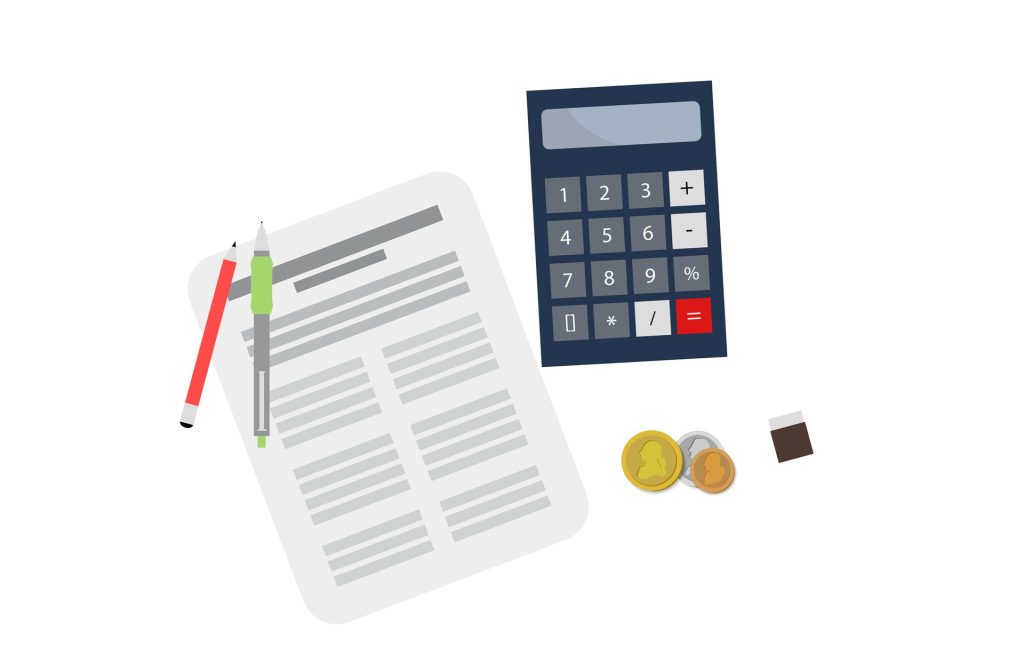
How To Manually Calculate Timesheet Work Hours
You can tally your work time or billable hours for each day using the steps below. In this example, we will be keeping it simple by walking you through how to calculate time for a typical workday or shift rather than a series of individual timed tasks or projects.
- Start with the times that you recorded starting work for the day, and the time that you recorded ending your daily work.
- You will need to convert these times into military time, or 24-hour time. This means that recorded times in the AM will remain unchanged, while any times recorded in the PM (after 12:00 PM) will be recorded as a consecutive sequence counting forward from 12:00. Example: 1:00 PM = 13:00, 2:00 PM = 14:00, 3:00 PM = 15:00, etc.
- After converting your start and end time to 24-hour time format, simply subtract the start time from the end time to determine the total number of hours worked for the shift. Example: If you started work at 8:00 AM and stopped work at 5:30 PM, after converting your hours you would then subtract 8:00 from 17:30 (5:30 PM) for a total of 9 hours 30 minutes.
- Finally, you will need to go back and subtract any break time that may have occurred throughout the day to determine the total work time billable hours for the shift.

Image Credit: vectorlab at DepositPhotos
How To Create A Free Calculator Timesheet
Depending on the spreadsheet program you choose you can make the process of tallying your work time easier by creating a calculator timesheet. You will need a basic understanding of how spreadsheet programs work, and how to create and apply a formula to generate the function you need, in this case, a calculator function that automatically converts and adds up your billable hours or work time.
In the example below, we will walk you through the steps to create a basic calculator timesheet.
- Start with a blank digital spreadsheet
- You will need to create a minimum of four unique columns: Date, Start Time, End Time, & Total Hours
- The cells in the Date column will be filled with the date of each individual shift or work period, one date per cell, per row
- The cells in the Start Time column will be filled with the starting time for each shift corresponding to the date at the start of the row
- The cells in the End Time column will be filled with the ending time for each shift corresponding to the date at the start of the row
- Create and apply a formula to the Total Hours column to calculate the work time for each shift date. Essentially, you will create a formula that subtracts the value in the Start Time cell for each row from the value in the End Time cell of the same row and converts the values to time format ([h]:mm)
These basic steps should be similar for most popular spreadsheet programs, however, you should consult the instructions for your chosen program for specific formula details, and any limitations, or advanced functions.
Project Time Management App

Image Credit: Datsyuk.lena at DepositPhotos
A project time management app combines project time tracking features with time management tools to create a robust team tracking, productivity tool that can also serve as a useful time tracker for individual or employee time tracking.
The built-in time management features of many project time tracking tools can help improve productivity by identifying time-wasting behaviors and encouraging users to adjust their work habits to make the best use of their time throughout the day.
The project time tracking function of these combined tools helps individuals, team leaders, and administrators create projects, and track the work time spent working to finish each project for an accurate accounting of expenses and billable hours throughout the course of the work, and after the project is completed.
A project time management app can help to hold individuals and teams accountable and improve collaboration between team members by presenting clear project timelines and priority tasks and displaying work schedules, and availability so everyone is looped in on what needs to get done, and when.
Additionally, project time tracking apps help both freelancers and team leaders make better budgeting and billing decisions based on the patterns identified through team tracking, and project time tracking functions.

Choosing The Best Project Time Management App For You
While there are a number of free tracking apps available, you will want to find a solution that functions as both a solid project time management solution and offers the ability to track your hours automatically as well.
We have provided a brief overview of two of the most popular time tracker apps that also provide robust project time tracking and time management functions.
Clockify
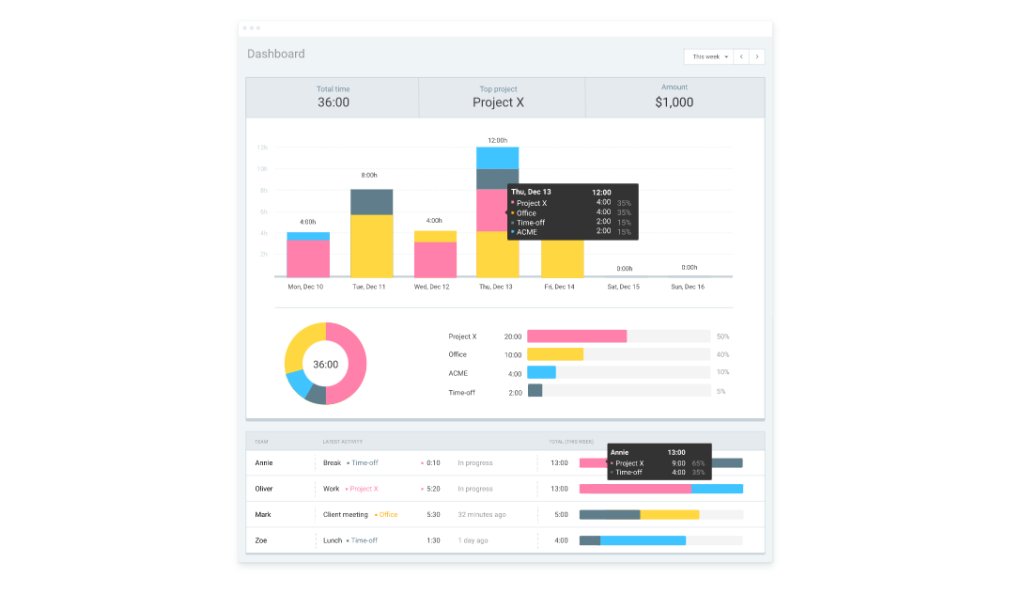
Clockify time tracker software allows users to automatically track and record daily and weekly hours by task, project, or client. The platform offers a free hours tracker tool that lets you track your hours in real-time and easily switch between tasks, or clock in and out with just a few clicks.
Clockify time tracker is able to serve as more than a simple work time app. Reporting features let users create and analyze reports on individual user work time, project timelines and costs, and much more. The information in these reports acts as a valuable tool to identify bottlenecks, time-wasting patterns, and budget-busting projects and tasks.
Additionally, a wide array of integrations allows users to use Clockify time tracker with many of the most popular project time management apps like Asana, Jira, Trello, Zapier, and many more.
Toggl Track
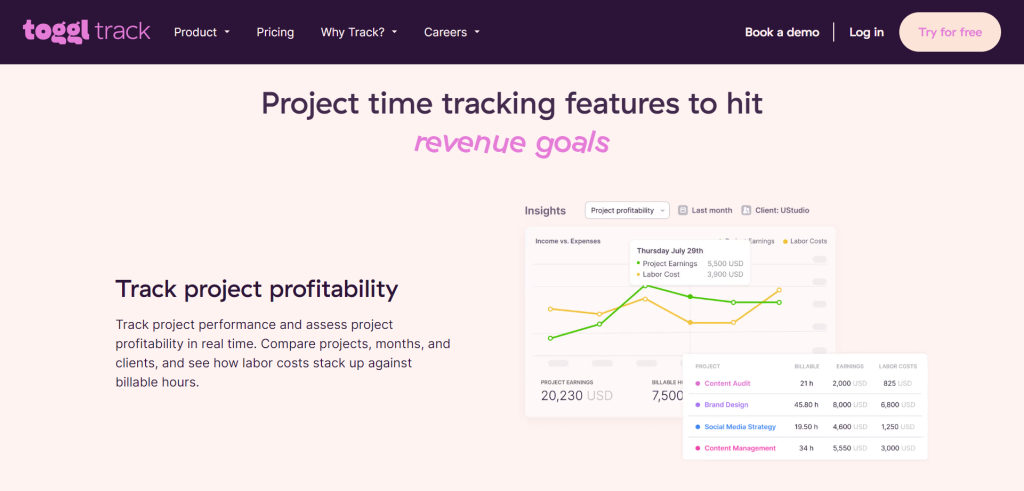
Toggl Track offers both paid and free time tracking software solutions that combine a work timesheet app with a solid set of project time tracking tools.
Toggl Track offers a user-friendly interface that makes it easy for both individual users and teams to clock in and out of tasks in real time. The automatic time tracker feature makes it quick and easy to track your hours down to the project or task.
The comprehensive dashboard allows users, and team leaders to generate reports on task and project time and expense budgets, and individual work hours and productivity.
Like Clockify time tracker, Toggl Track can be integrated with a wide range of popular project time management apps offering users the best of both worlds. The free version of Toggl Track offers solid project time management and time tracking capabilities for a limited number of users. Larger teams will need to purchase the paid version. This makes Toggl Track a solid time tracker for freelancers and small teams but it may be a bit pricey for larger organizations.
Time Tracking Tool

Image Credit: samuraitop at DepositPhotos
Of course, if you are simply looking for a way to track your hours you can find several straightforward time tracking tools as well. In this section, we will explore a couple of solid free and paid time tracking options that will allow you to start tracking your hours accurately, simply, and easily.
Top Paid Time Tracker: Track My Hours
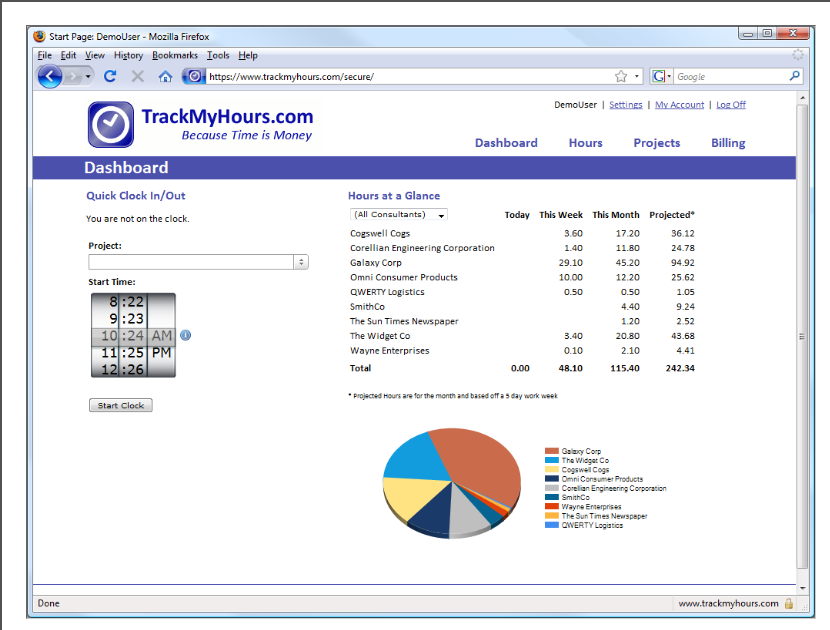
Track My Hours is a robust time tracking tool that offers a simple, easy-to-navigate user interface that will allow you to track your hours in real-time right from the web app. Users can also clock in and clock out of tasks using the included clock tray option integrated into the Windows taskbar. There is also an option to simply enter and track your hours manually by entering your start and end times for each task in the online work timesheet app. Users can also review and edit previously logged hours at a later time if corrections are needed.
For a simple timer app, Track My Hours is far from bare bones. The tool offers several project time tracking functions that allow it to serve as a time management app as well. Users can assign work hours by task or project, designate work hours as billable or non-billable, and label hours according to project or client.
Additionally, Track My Hours includes several accounting and billing features that will allow you to create invoices and export them to popular accounting programs like QuickBooks for easy processing, email invoices directly to clients, or download and save them for manual presentation or recordkeeping.
Top Free Time Tracker: My Hours
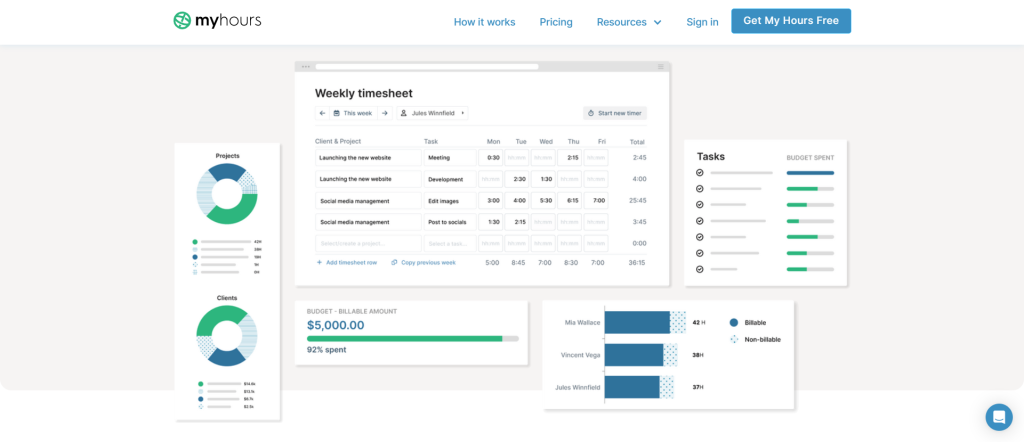
My Hours offers a user-friendly automated time tracker solution that allows freelancers, contractors, team leads, and business administrators to automate the time tracking process.
The free version of My Hours allows an unlimited number of team members to track their work hours across an unlimited number of projects and tasks, with an unlimited array of billable rates. Users are also able to generate basic reports to help identify time-wasting patterns, and budget-busting projects and tasks. Track your hours on desktop, iOs, or Android for free, and integrate with Zapier for even greater functionality.
The comprehensive set of functions, all available for free, with no restrictions on the number of users, clients, projects, or tasks makes My Hours a solid free time tracker for freelancers, as well as agencies, organizations, and businesses of all types and sizes. For those who find that they do need more robust invoicing, accounting, and billing functions at some point down the road, these features are readily available in the My Hours paid package priced at $9 per user per month at the time of this writing.
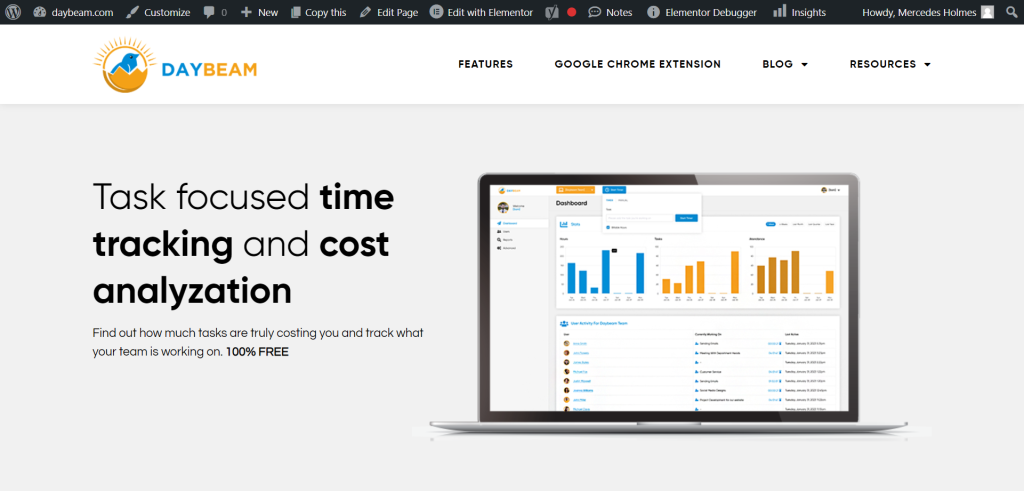
Final Thoughts
Regardless of the scope of your business, be it a solo operation or a larger organization, the ability to accurately track your hours, and ensure that you receive fair payment for your dedicated time and effort is a constant. We hope that the techniques, tips, and tools shared in this article will provide the resources you need to start tracking your hours, managing your time, optimizing your productivity, showcasing your value, and seeing a return on all your hard work.
Choose the best option for you and start tracking your hours and boost your earning now!








